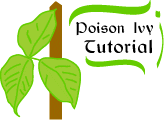

Poison ivy is a member of the Cashew Family (Anacardiaceae), and I've seen it listed as Toxicodendron radicans and in more recent books as Rhus radicans. It can appear as a ground cover, a shrub, or as a vine growing up a tree. Older vines are covered in fibrous roots resembling hair that grow into the supporting tree. It has dull or glossy compound leaves on a long stem that are divided into 3 leaflets, each 2-4" (5-10 cm) long. The leaflets can be slightly lobed, and are a dark waxy green, above, and light, fuzzier beneath. A short stem sets off the end leaf.
Poison ivy flowers May through July in yellowish-white (possibly green) clusters, 1-3" (2.5-7.5 cm) long at the leaf axils. The flowers are 1/8" (3 mm) wide. In fall, poison ivy leaves turn red. Between August and November, poison ivy develops white or gray hairless fruit to 1/4" (6 mm) wide, in clusters that stay through winter and into spring, when not eaten by birds. Dead leaves and stems may have black stains on them, due to the oxidation of the urushiol oil.
Poison ivy grows throughout eastern North America, while its counterpart, poison oak, grows in western North America and has hairy fruit. Both can be found in Bermuda and the Bahamas. Poison ivy and poison oak grow in open woods, thickets, fence rows, stone walls, roadsides, and waste places. On roadsides, it tends to be ground cover, and in sandy coastal areas, it tends to be an erect shrub. In woods, you'll mostly see the vines on trees.